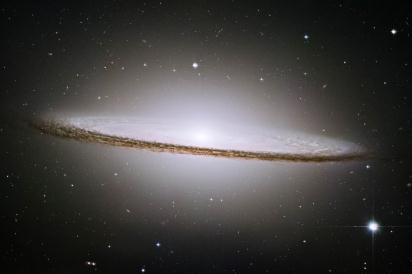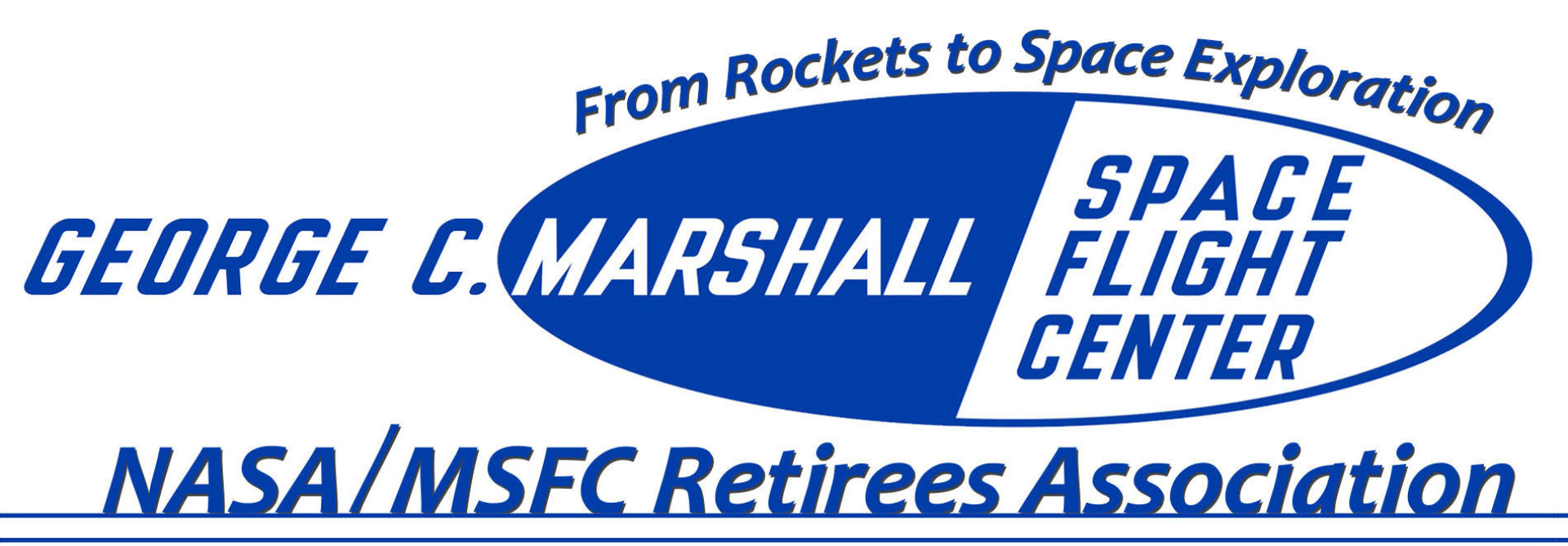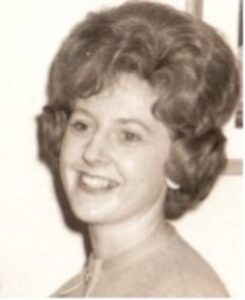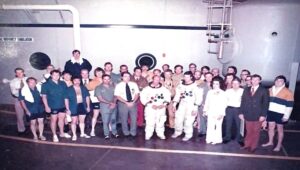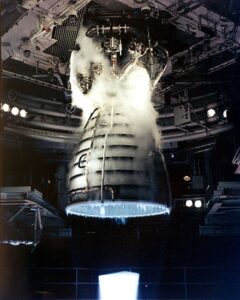by Spike Field
Astronomers dreamed of viewing the cosmos long before man-made satellites were able to go into space. That dream became viable after the Apollo lunar program and other satellites demonstrated that an orbiting platform could be held stable long enough to provide exceptionally high-resolution data from cosmic objects.
As early as ’23, Hermann Oberth, a German rocket pioneer, suggested putting a telescope into orbit above the Earth’s atmosphere. In ‘46, Dr. Lyman Spitzer, a theoretical physicist and astronomer at Princeton University, postulated that resolution of the Palomar telescope was only 60 times better than the human eye, but, if it were operated above the atmosphere, it could be 3,000 times better.
Soon after the Apollo 11 moon landing in ‘69, Spitzer asked Dr. C. Robert O’Dell to be the “point man” for the greater astronomy community, suggesting that he work as a civil servant scientist within NASA. Bob reluctantly gave up his career as a professor at the University of Chicago and Director of the Yerkes Observatory to become a government scientist at the Marshall Space Flight Center and to represent university interests in the development of the new large space telescope that became known as the Hubble Space Telescope.
Jim Downey led the telescope definition team within the Program Development Division at Marshall. Jim was the leader when I joined the team after leaving Skylab, Jean Olivier was chief engineer, and Bob O’Dell was astronomer-scientist. Others to come onboard from Skylab at the same time, included Bill Keathley, Max Rosenthal, and John Humphreys. Marshall’s Astronautics Lab supported the study effort, including optics specialist, Dr. Joe Randall, and control system expert, Dr. Gerald Nurre. This was the beginning of a project team that would manage and direct the design and development of the Hubble Space Telescope.
Establishing an engineering team to plan the space telescope development was one thing, but it was most important to have knowledgeable input from the university-based astronomy community. A small group of astronomers and instrument scientists occasionally met with NASA engineers during “working group” meetings, which provided a forum for defining design and operational criteria. Bob O’Dell was chairman at the meetings. I attended as an observer, listening and learning while various telescope design features were discussed.
The astronomers were visionaries (pun not intended) who operated on a different technical level than engineers. However, one key scientist, Jim Westphal, had a knack for explaining astrophysics and scientific instrumentation in a way that even I could understand. He was a geophysicist by training (not an astronomer, or PhD) and had previously designed and built large telescope light-sensing instruments. He was also a distinguished professor at Cal Tech, which said a lot about him! Another telescope expert I found easy to talk with was Bill Fastie. Both Jim and Bill had built instruments used at Palomar and other ground-based observatories.
In-house design studies and prototype testing progressed hesitatingly until ’77 when the project was funded for contracting with Industry for the design and production of flight hardware.
Marshall Space Flight Center had the project responsibility for the telescope portion (Optical Telescope Assembly) and the spacecraft control section (Systems Support Module). The Goddard Space Flight Center at Greenbelt, MD was responsible for development of the telescope’s Scientific Instruments, and building a Science Center where the orbiting Hubble was to be operationally controlled, and where astronomers would implement their observations.
Three Module Configuration
Hubble’s flight hardware consisted of three major elements: Optical Telescope Assembly (OTA), Support Systems Module (SSM) and Science Instruments (SI).
Optical Telescope Assembly (OTA)
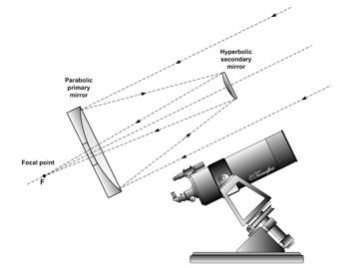
The major element of the Optical Telescope Assembly was a Cassegrain reflector-mirror assembly of a Richey-Cretien design. The primary and secondary mirrors were made of Ultra Low Expansion (ULE) glass. A graphite-epoxy structure, called a metering truss, separated the two mirrors, and narrow, annular light baffles were attached inside the truss to attenuate reflected stray-light. The Science Instruments (SI) were positioned behind the primary mirror where they registered photons and radiated energy coming from cosmic objects being observed. Fine Guidance Sensors (FGSs) provided stability reference data using known bright stars. The adjacent schematic illustrates how light is reflected off the two mirrors, then passes through a hole at the center of the primary mirror to a “focal plane” located behind the primary mirror.
Bill Keathley led the OTA project during preliminary design from ‘74 until ’77, at which time he became the Marshall Space Flight Center’s Hubble Program Director.
Systems Support Module (SSM)
The Systems Support Module was a platform that supported and enclosed the OTA and Science Instrument assembly. It performed all spacecraft functions and shielded the telescope assembly from direct sun radiation, reflected light, and thermal variations as Hubble orbited the earth. Its principal job was to point the telescope’s line of sight toward selected areas in the sky and hold very still while the Scientific Instrument sensors registered light photons and radiation data. The SSM contained all systems needed to operate orbital spacecraft functions, such as attitude control, electrical power generation and distribution, command control, telemetry, and data management – all needed to support the OTA.
The SSM’s most challenging design requirement was to move the telescope’s line-of-sight from one celestial object to another within a pointing accuracy of 0.01 arc-seconds, and then hold on to an “object of interest” with a stability of 0.007 arc-seconds for up to 24-hours duration. To appreciate this requirement – if the telescope were in Washington, DC it could focus on a dime in Boston and not stray from the width of the coin.
The key to assuring long orbital lifetime was a unique requirement to have astronauts perform on-orbit maintenance. This was derived from Skylab experience when launch-damaged hardware was repaired and failed components were replaced by astronauts, thereby allowing completion of all three planned missions. Based on that experience, Hubble was specifically designed for replacement of Science Instruments and critical components during planned on- orbit maintenance missions. I delivered two papers at symposia on the subject: 1) The Space Telescope, A Long-Life Flyer, given at the November ‘79 American Astronautical Society’s Annual Meeting, and 2) the Space Telescope Design for Maintenance given at the IEEE ESCON 80 Conference in Oct. ‘80.
I was the Marshall Center’s project manager for the Support Systems Module. The job was to manage and direct hardware design and development effort contracted to Industry.
Science Instruments (SI)
Five Science Instruments, located at the OTA focal plane to sense and record observed data, were: 1) Wide Field and Planetary Camera (WF/PC); 2) High Resolution Spectrograph (HRS); 3) High Speed Photometer (HSP); 4) Faint Object Camera (FOC); and 5) Faint Object Spectrograph (FOS). The cameras recorded visual wavelength data that produced photographic-type images. The spectrograph instruments recorded ultraviolet and infrared data used to determine the chemical composition of celestial objects The photometer instrument used photon-counting digicons to measure the flux, or intensity, of an object’s electromagnetic radiation. George Levin at the Goddard Space Flight Center managed development of the Science Instruments.
The Wide Field and Planetary Camera (WF/PC) proved to be the most productive Hubble Science Instrument. It recorded the many high-resolution photographic-type images that amazed the world’s science community and sparked the public’s interest. As a high-resolution imaging device primarily intended to register optical image data, it could also detect near infrared and UV data using filters. Charged Couple Device (CCD) arrays were used to sense light and register the intensity of photons during observation periods. The original WF/PC instrument, and later orbital replacements, produced over 80% of the highly acclaimed discoveries credited to Hubble during its 20-plus years of operational lifetime. Cal Tech’s Jim Westphal was the Principal Investigator (PI) responsible for the WF/PC design, and he gets the major credit, in my book, for Hubble’s phenomenal success.
Project Planning & Implementation
Financial constraints and frequent estimate-to-completion revisions plagued the project throughout preliminary design and continued during the development phases. During the early years, the project’s future was constantly in doubt as the design approach and estimated cost were kicked about between the Goddard and Marshall Centers, NASA Headquarters, Congress, and various astronomers. Early in ’72, Goddard estimated approximately $500 million; and Marshall estimated $900 million for a plan that included a ground-test breadboard, an all- systems test article, and one flight article. When NASA Administrator, James C. Fletcher, was told of these estimates, he reacted by arbitrarily pulling a number out of the air, saying that NASA’s fiscal climate at the time was not conducive for starting large projects. A “back to the drawing board” effort resulted in deleting most ground test hardware, leaving only a single proto- flight article. To enable on-orbit replacement by astronauts, a uniform Science Instrument envelope about the size of a telephone booth was chosen. Also, an earlier plan to return Hubble to earth for major overhauls was deemphasized in favor of having astronauts replace failed components during on-orbit maintenance operations.
From the very beginning, the Marshall Center was in competition with Goddard for the project’s principal management role. With encouragement from university astronomers, the spacecraft and telescope hardware development job was assigned to Marshall, and Goddard got the long- term job of managing and operating the observation mission phase after launch. There was an apparent atmosphere of rancor between the Centers then, and continued for years.
Because astronomers from several countries were planning to use Hubble for observations, it was appropriate that the international community partner with NASA to help pay for the development. Discussions between NASA Headquarters, Marshall, Goddard, the European Space Agency (ESA), and even Congressional Committees resulted in a plan for European interests to supply the SSM solar arrays and one Scientific Instrument. For the consideration of future scientific viewing time, ESA’s 15 % contribution was based on the estimated cost for hardware items it supplied, as compared to the total estimated development cost, exclusive of orbital phase operational costs.
Officials at NASA Headquarters believed that the Marshall Center’s historical propensity to provide technical support, advice and direction to its contractors resulted in excessive project cost. Headquarters believed that the magnitude of cost overruns was directly proportional to the number of civil servants assigned to work on projects. Using that rationale, Headquarters directed Marshall to limit the number of government personnel working on Hubble.
Contracting to Industry
Preliminary design contracts were awarded to selected companies considered to have the capability to build the hardware. Itec and Perkin Elmer were chosen for the OTA package preliminary design competition; and the SSM spacecraft preliminary design competition Boeing, Lockheed, McDonnell Douglas and Martin Marietta were selected. The Goddard Center chose Princeton and Johns Hopkins Universities to submit plans for the Science Center. Also, various university-based astronomers were chosen to refine the design requirements for the U. S. supplied Science Instruments.
During the preliminary design phase, three telescope sizes, with primary mirror diameters of 1.0, 2.4, and 3.0 meters, were studied. It was well known that the astronomer community preferred the largest possible diameter mirror that could fit in the shuttle’s payload, but high costs would prohibit selling it to NASA Headquarters and Congressional interests. Furthermore, a 2.4-meter diameter mirror had already been made for military applications, so the mirror size became a foregone conclusion.
The next phase of the procurement cycle was for detailed design, development testing, production, and delivery of hardware. Proposals from competing contractors were evaluated by NASA Source Evaluation Boards (SEBs). The fun part of evaluating proposals was to visit contractor plants to see the facilities and meet the management teams proposed to work on the project. This photo of Jim Downey, Jean Olivier and me (in the middle) was taken while visiting one of the competing SSM contractors.
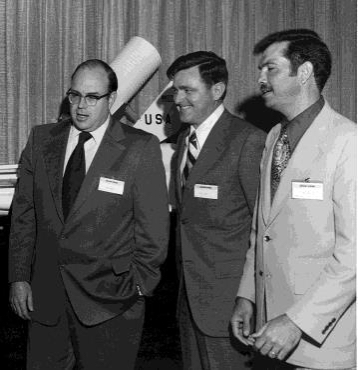
Bill Keathley was the OTA Source Evaluation Board (SEB) chairman and I was the SSM SEB chairman. Before beginning evaluation activity, a potential conflict of interest question was raised because my brother-in-law was a Lockheed employee at the time. NASA’s legal staff quickly put it aside because he was in an engineering group – not in management. Technical and business SEB teams scoured the proposals, looking for strengths, weaknesses and discriminators. When completed, the Center Director, Jim Downey, Bill Keathley and I went to Washington in July ‘77 to brief NASA Headquarters. Robert A. Frosch, NASA Administrator at the time, chose Lockheed for the SSM and Perkin Elmer for the OTA. Johns Hopkins University was selected as the site for the Science Center.
With NASA ready to commit major dollars for detailed design, Marshall established the new Hubble Program Office and assigned Bill Keathley as Hubble Program Director. Max Rosenthal replaced Bill as the OTA project manager, and I continued as the SSM project manager.
Negotiating the SSM contract with Lockheed was a simple matter of agreeing to boilerplate language, estimated cost, and using the SSM Model Specification as the technical statement of work. Lockheed was cautioned to gradually increase manpower levels and to make sure that Perkin Elmer’s OTA interface design was fully coordinated. Bill Wright was the Lockheed SSM program manager and Bert Bulkin was his deputy. Both had extensive experience working on defense-related satellite jobs and the company had plenty of engineers with appropriate hardware and software experience.
The European Space Agency (ESA) assigned the SSM solar arrays and Faint Object Camera (FOC) developments to industrial firms in several countries. British Aerospace (BAe) at Bristol, England had the overall solar array job and subcontracted the solar cells to Telefunken at Hamburg, Germany. EMI in London, and Matra in Paris, developed Faint Object Camera components that were later integrated and tested by ESA at Leiden, Holland.
I flew to Europe several times to check on contractor progress and to meet with ESA counterparts. The trips were always busy, but were fun because of the sightseeing potential and opportunities to eat different foods. Driving in Paris was a challenge, especially in heavy traffic going around the Arc de Triumph’s six lanes at night, and in the rain! Also, taking the high- speed train from London to Paris via the Chunnel (English Channel Tunnel) was a new experience.
Hardware and Operational Requirements
The SSM equipment section was a rugged annular box structure, or ring, designed to contain the components and subsystems necessary to operate Hubble. The entire mass of the OTA was supported at a three-point interface inside the equipment section ring. Solar arrays, magnetic torquers and high-gain antennae were attached to the external surface of the equipment section. The rest of the SSM structure, extending fore and aft of the equipment section, consisted of cylindrical aluminum shells and multi-layer insulation to shield the OTA and Scientific Instruments from the sun’s thermal energy and stray light. A hinged door at the front end acted as a sunshade to minimize direct and reflected light from entering the aperture.
Control moment gyros (CMG’s) were reaction wheels located in the equipment section near the Hubble’s center of gravity. Three CMG’s delivered the reactive forces necessary to move Hubble from one celestial object to another, and then hold it stable while light and radiation data from the target star was being registered by Science Instrument. Acceleration of the wheels, operating in either direction, reacted against Hubble’s mass to cause it to move. CMG wheel rotational speed could potentially build up to 3000 rpm, so stored energy was managed with use of magnetic torquers that reacted against the Earth’s magnetic field. Three CMG’s were needed for spacecraft attitude control, but two could do the job if one failed.
Rate gyros provided an inertial reference when moving the telescope and helped maintain stability during viewing. While observing a faint objective, at least two Fixed Head Star Trackers (FHS) locked on to known, brighter “guide stars” that were used to determine Hubble’s location in space and to provide error signals for pointing stability.
SSM solar arrays converted sunlight radiation to approximately 6000 watts of electrical power. When the telescope moved from one target star to another, the arrays automatically moved to keep them normal to the sun to assure maximum power generation. Electrical energy generated by the arrays was stored in batteries and used to operate components and subsystems. Ground commands were received and telemetry data transmitted through low-gain antennae. Science data was downlinked using articulating high-gain antenna directed at synchronous satellites, which relayed the data to ground stations.
Hubble was exposed to extreme heat variations during each orbit while orbiting Earth while going from “night to day” every 96 minutes. To minimize the effects of temperature extremes on mirror alignment and instrument performance, the outside of the SSM was covered with multiple layers of a mirror-like Mylar material to block the sun’s radiation and insulate the OTA. A hinged door at the front end helped prevent direct sunlight and earth’s albedo light from entering the aperture. The door was closed during launch and when Hubble was being serviced during maintenance missions.
Project Events and Personal Notes
Just before Christmas ’79, Bill Keathley moved to an apartment near my home after his wife initiated divorce proceedings. He did not have a car at first, so I drove him to work for a couple of weeks. While driving back and forth we naturally discussed the project. One day, he surprised me by asking what I thought the Center Director (his direct boss) would do if Hubble were severely overrun. I replied without hesitating that “he would probably crucify you.” Shortly after that exchange, Bill announced that he was leaving Marshall to take a promotion at Goddard. Most assuredly, his departure was not a result of my answer; however, my theory as to why Goddard hired Bill away from Marshall could have been because he won most of the project turf battles between the two centers. By hiring him, Goddard removed their nemesis. The saying goes, “If you can’t beat ‘em, hire ‘em!
Just after Keathley left, I asked the Center Director, Bill Lucas, for the Hubble Project Director’s job. He said he would consider it, but a week later it was announced that Dr. Fred Speer was to be the new Hubble director. Fred had just come off the HEAO project that was finished under cost, although a couple of flight items had been deleted from the original plan to keep project cost down. Fred’s cost-saving deletions pleased NASA management; however, the HEAO astronomer scientists were not happy.
Fred and I got along well and he seemed pleased with the way I managed the Lockheed contract. When my job title was changed from “SSM Project Manager” to “Space Telescope Associate Director for SSM” (without a corresponding financial reward), it was apparent that they threw a bone for me to chew on.
In the Spring of ’80, an opportunity came to combine a business/vacation trip with my wife, Bettie, that included personal leave time. While I attended meetings at ESA, she strolled around Leiden and was given a personal tour of an old windmill museum located in the center of town. After the meetings were completed, my vacation began so we took a train to Austria to visit old friends and prior Huntsville neighbors. Fritz and Anna Marie Brander drove us to Vienna to see the city where he grew up, and gave us a personal tour of St. Stephen’s Cathedral, Karl’s Kirk, and a cellar where Holy Roman Empire royal heads of state were entombed. In the middle of my vacation, Fred Speer called, asking me to go to Bristol for an unscheduled meeting with BAe. The trip became a four-week marathon, and I resolved that was the last time I would combine vacation with a business.
Lockheed Missiles and Space Division’s work on the SSM progressed satisfactorily, however, timely polishing of the primary mirror at Perkin Elmer’ (P-E) was a chronic concern. Corning delivered the primary mirror blank on schedule, but P-E had difficulties learning to use their new, computer-driven, polishing equipment. As a result, the schedule was progressively squeezed, and estimated cost-to-completion rose inversely as the schedule was compressed. The photo shows the primary mirror being polished at the P-E plant in Danbury, Connecticut.
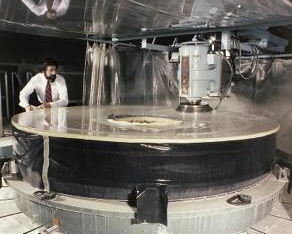
Progress at Perkin-Elmer continued to lag, further contributing to Hubble’s cost and schedule problems, so Fred began looking for ways to cut overall project costs and hopefully enjoy the fiscal success he had on the HEAO Program. His first idea was to eliminate the aperture door, which was there to block light that would otherwise degrade the quality of exposures. The door also protected mirror surfaces from being contaminated during launch and maintenance operations. Bob O’Dell objected strenuously, as did every astronomer, so that idea was quickly dropped.
Next, Fred decided to eliminate the majority of launch replaceable units (LRUs), and their corresponding flight hardware interfaces, including handholds that astronauts would need to replace failed items such as gyros and electronic packages. His objective was to avoid cost. Fred was convinced that he had to do it to hold down the ever-increasing project estimates, in spite of the obvious risks to orbital longevity. After much discussion, I reluctantly directed Lockheed to delete the LRU interface designs and handholds, knowing that if any critical item were to fail while in orbit, it could not be replaced and Hubble’s operational lifetime potential would be severely shortened.
The work at Perkin-Elmer (P-E) continued behind schedule and seemed to get worse each quarter. Primary mirror polishing was hesitatingly slow. In early ’81, P-E stated that the polishing was nearly complete and that the mirror had an almost perfect “figure.” Mirror figure measuring techniques, using available instrumentation, confirmed their opinion; however, it was actually flawed, but not discovered until after Hubble was launched and in orbit a decade later. An issue was discussed about that time regarding a P-E request for additional funding to buy test equipment that required a facility modification. It was refused; however, such requests were not unusual, as P-E frequently asked for additional funds. It may never be known if the equipment and facility mod that was disapproved might have helped reveal the flaw that was discovered after launch.
During the late spring of ’81 Marshall conducted a Critical Design Review (CDR) at Lockheed. CDR’s are a major review milestone that require the government to conduct detailed evaluation of the contractor’s design and development results before proceeding with building flight hardware. The review at Lockheed was completed without significant problems, and I authorized the contractor to proceed with manufacturing.
Opportunity Knocks
Just before the July 4th holiday weekend in ’81, NASA offered an early-out retirement option for personnel who met the age and time-in-service criteria. I was tempted and talked it over with Bettie, who said, as always, “If that is what you want, do it” It would be a big step and I thought long and hard while painting the dormer on our home that weekend. With 25 years of service, including military time, I qualified, so I decided to do it. Bettie cheerfully agreed and the next day I went to the personnel office to file the appropriate papers. A long line was standing there, also applying for retirement. Over 300 signed up before the option was shut down. Fred Speer appeared shocked when I told him; however, he asked me to stay on until after the European hardware CDR’s were completed.
During the month of August ‘81, a small team went to Europe to conduct CDR design reviews of ESA’s hardware. First, we went to Bristol for the solar array CDR. Next, the Faint Object Camera (FOC) component designs and prototypes were examined at EMI in London and at Matra in Paris. The last review was Telefunken’s solar cell development in Hamburg. During the last evening, the ESA Hubble Project Manager, Jon Berger, took several of us to dinner at a country inn, the Rosengarten, where we were introduced to the strange flavor of eel, a delicacy for our host, but not for us.
Back at Marshall, I spent a few days cleaning up loose ends and was entertained at a coffee and cake farewell party on September 25, 1981 marking the end of my NASA career. I was 53 years young! While driving home that day, I reflected on the fact that it was the first time in my life that I was not employed. It was a strange feeling.
After Leaving, a Post Script
Two years after I retired from NASA, Bob O’Dell and Fred Speer left to pursue their careers elsewhere. The new Hubble director, Jim Odom, reinstated all the LRUs and handholds that Fred had ordered be deleted. It is noted that Jim was one of the first engineers I recruited for the Saturn S-II Project Office twenty years earlier. The OTA assembly was nearing completion at Perkin-Elmer’s Danbury plant, but the Science Instruments had not been delivered yet, so interfaces had to be verified at Sunnyvale. After all hardware elements were assembled, a full- up systems checkout of the integrated Hubble (SSM, OTA and Science Instruments) was conducted at the Lockheed-Sunnyvale plant.
Hubble had been scheduled for launch in ‘86, however, the Challenger’s tragic failure and loss of life in January ’86 caused a hiatus for all Shuttle launches, including Hubble’s launch. The down-time for Hubble was used for continued testing and evaluation of the telescope’s readiness at the Lockheed facility, followed by long-time storage in a vacuum chamber, needed to protect sensitive optical surfaces from atmospheric contamination.
After the Shuttle Program returned to flight status, Hubble was delivered to the Kennedy Space Center and launched aboard Shuttle Discovery in April ‘90. Hubble was deployed remotely by shuttle astronauts and parked in a nearly circular orbit about 340 miles above earth at an inclination of 28.5 degrees. At the Science Center, Marshall engineers and Hubble contractors conducted on-orbit deployment and flight verification operations before handing operational control over to the Goddard engineers, along with eager astronomers, ready to conduct their “observations.”
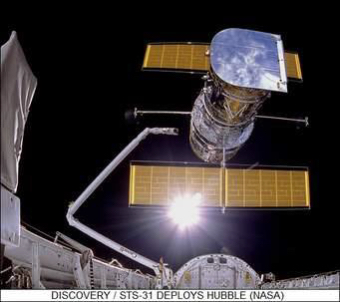
It was not long before astronomers working at Goddard discovered that the quality of some optical images were unacceptable. The telescope’s ability to focus on faint objects was compromised. It was deduced from the evidence that the primary mirror had been shaped incorrectly during polishing at Perkin Elmer. A spherical aberration resulted in an out-of-focus distortion. The mirror’s figure was too flat near the outer edge by about 1/50th the width of a human hair. Instead of focusing light photons at the focal plane as intended, photons were spread over a larger area, thus producing a fuzzy halo effect. As a consequence, images of objects such as faint stars and galaxies were blurred.
The flaw did not affect spectroscopic observations, and bright object observations were largely unaffected; however, an out-of-focus halo surrounded faint objects severely compromising the usefulness of the telescope. Nearly all of the cosmological programs that required observation of exceptionally faint objects were negated. Both NASA and the Hubble Space Telescope became the butt of jokes in the media.
In spite of loss of cosmological viewing, Hubble carried out a large number of productive observations during the first three years of on-orbit operations before repairs could be attempted. Because the flaw was well characterized and stable, astronomers were able to optimize the results obtained using sophisticated image processing techniques, however, very distant faint objects could not be viewed. They had to wait until after the first servicing mission to obtain the phenomenal images that amazed the world.
The first Shuttle Servicing Mission (SM1) flew in December ’93, delivering two replacement scientific instruments designed to compensate for the primary mirror’s incorrect shape. Astronaunts aboard the Shuttle went EVA to install a number of Launch Replaceable Units (LRUs). The solar arrays were replaced with a newer design to help reduce low frequency vibrations caused by thermal flexing when orbiting the Earth. Gyroscopes and some electronic units were replaced. The mission was one of the most complex EVA operations ever undertaken, involving five lengthy spacewalk periods. It was a resounding success for NASA, and for Hubble it was an enormous boon. This first servicing mission not only improved Hubble’s vision, which led to a string of remarkable discoveries, it also clearly validated the effectiveness of on-orbit servicing by astronauts, which Marshall engineers had championed following their Skylab experience.
After Hubble’s new “eyeglasses” were installed, images were significantly sharper, as shown by exposures of Pluto and Charon taken before correction (left) in 1990, and after correction (right) in 1994.

The second servicing mission (SM2), in February ’97, delivered two new scientific instrumentand replaced a tape recorder with a solid-state recorder. In addition, the Shuttle was able to boost Hubble to a higher orbit after maintenance operations were completed.
The SM3A servicing mission in December ’99, replaced all six gyroscopes, a fine guidance sensor, the flight computer, and thermal blankets on top of the original reflective foil. The SM3B servicing mission in March ’02 replaced the last original instrument that was still on board, and a new cooling system was also installed for use by an infrared instrument.
Servicing mission, SM4, was postponed, and then cancelled after the tragic loss of the space shuttle Columbia in February ‘03. Following the disaster, and re-examining risks, the last Hubble servicing mission was launched in May ‘09. It was Hubble’s most challenging and intense servicing mission. Over the course of five spacewalks, astronauts installed two new instruments that improved the earlier optical fixes for the spherical aberration problem. The new instruments increased Hubble’s observational capabilities in the ultraviolet and visible spectral ranges by a factor of 35. Also, astronauts were able to repair two other failed instruments and replace rate gyros, a fine guidance sensor, a Science Instrument command data handling unit, and six nickel-hydrogen batteries. The original batteries had not been replaced during prior servicing missions and were 13 years beyond their design lifetime. The SM4 crew took the photo of Hubble as the Shuttle pulled away for the last time. There would not be another servicing mission because the Shuttle Program ended in 2011.

Observation Results
Hubble helped resolve some long-standing problems in astronomy, as well as turn up results that require new theories to explain them.
While Hubble observations helped refine estimates of the age of the universe, it also cast doubt on theories about its future. By observing distant supernovae, astronomers uncovered evidence that, far from decelerating under the influence of gravity, the expansion of the universe may, in fact, be accelerating.
Hubble showed that black holes are probably common at the centers of all galaxies, and studies of the data established that the masses of nuclear black holes and the properties of galaxies are closely related.
The collision of Comet Shoemaker-Levy 9 with the planet Jupiter in ‘94 was fortuitously timed for astronomers, coming just a few months after servicing mission SM1 had restored Hubble’s optical performance. Images taken of the planet were sharper than any taken since the passage of Voyager 2 in ‘79, and were crucial in studying the dynamics of the collision of the comet with Jupiter, an event believed to occur once every few centuries.
Other discoveries included evidence of the presence of planets around sun-like stars and the optical counterparts of mysterious gamma ray bursts. Hubble also observed objects in the outer reaches of our Solar System, including the dwarf planets, Pluto and Eris.
Before Hubble, no telescope had the resolution to see distant galaxies. This image was called the Hubble Deep Field. Intrigued by its potential, astronomers turned Hubble cameras on what appeared to be a extremely long exposure that could have been used for other high priority needs; however, the results turned up a treasure trove of 3,000 galaxies, large and small, shapely and amorphous – all burning in the depths of space.
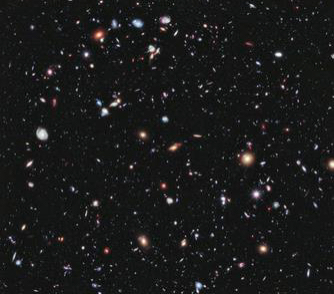
Hubble produced many images that helped improve the understanding of processes inside nebula. One of these, a photograph known as the Pillars of Creation, depicts large region o star formation. The small, dark areas are believed to be protostars. The columns, which resemble stalagmites protruding from the floor of a cavern, are composed of interstellar hydrogen gas and dust, which act as incubators for new stars. Inside, and on their surface, astronomers found knots, or globules of denser gas, called evaporating gaseous globules. Stars are being formed inside a portion of these globules.
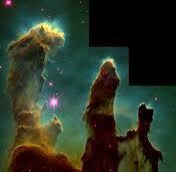
The Sombrero Galaxy, M104, is about 28 million light years away from Earth. This image was voted the best picture taken by Hubble. Dimensions of the galaxy are as spectacular as its appearance. It has 800 billion suns, and is 50,000 light years across.
